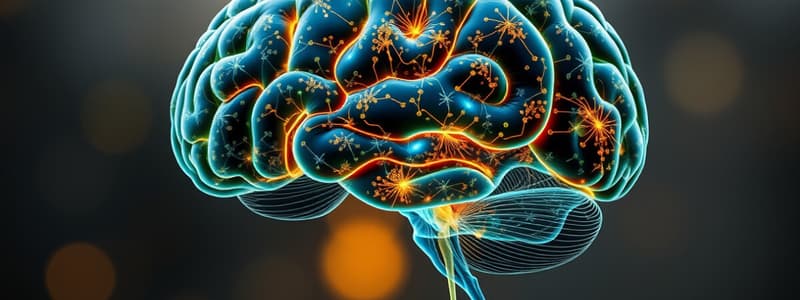Podcast
Questions and Answers
Which of the following best describes the difference between biological and chronological age?
Which of the following best describes the difference between biological and chronological age?
- Chronological age indicates a person's health, while biological age indicates their educational level.
- Biological age reflects the developmental state of the body, while chronological age is the actual age. (correct)
- Both biological and chronological age are the same and indicate the same information.
- Biological age is determined solely by genetics and lifestyle, whereas chronological age is uniformly shared.
Erikson's first stage of psychosocial development is autonomy vs. shame and doubt.
Erikson's first stage of psychosocial development is autonomy vs. shame and doubt.
False (B)
What are the three stages of prenatal development?
What are the three stages of prenatal development?
germinal, embryonic, fetal
The __________ test is administered shortly after birth to evaluate a newborn's health.
The __________ test is administered shortly after birth to evaluate a newborn's health.
Match the following forms of genotype-environment correlation with their descriptions:
Match the following forms of genotype-environment correlation with their descriptions:
Which of the following best characterizes the difference between fraternal and identical twins?
Which of the following best characterizes the difference between fraternal and identical twins?
The epigenetic view suggests that genes are static and do not change over time.
The epigenetic view suggests that genes are static and do not change over time.
What are the four lobes of the brain?
What are the four lobes of the brain?
Flashcards are hidden until you start studying
Study Notes
General Tips
- Questions are encouraged; utilize office hours or email for assistance.
- The lowest exam score will be dropped, providing a safety net.
- Stay calm and confident about your knowledge.
The Lifespan Perspective (Section 1)
- Understand the distinctions among biological (physical changes), cognitive (mental processes), and socioemotional development (emotional and social changes).
- Differentiate between chronological age (actual age) and biological age (physical health and body functioning).
- Explore the nature vs. nurture debate regarding the influence of genetics (nature) versus environment (nurture) on development.
Erikson's Psychosocial Theory of Development
- First stage: Trust vs. Mistrust - critical for forming secure attachments.
- Second stage: Autonomy vs. Shame and Doubt - involves developing a sense of personal control.
Bronfenbrenner's Ecological Theory of Development
- Familiarity with the ecological model's systems:
- Microsystem: Immediate environment (family, school).
- Mesosystem: Interconnections between microsystems.
- Exosystem: External environments that indirectly influence development.
- Macrosystem: Cultural and societal influences.
- Chronosystem: Influence of time and transitions across the lifespan.
Cultural Influences on Aging
- As the benefits of evolutionary selection diminish with age, the reliance on cultural practices and knowledge amplifies.
Beginnings (Section 2)
- DNA: The double helix structure that carries genetic information.
- Fertilization: The process in which an egg and sperm unite.
- Phenotype: Observable characteristics derived from the genotype.
- Susceptibility and longevity genes influence health and lifespan.
- Epigenetic view: Interaction between genes and environmental influences.
- Teratogen: Any substance that can cause developmental malformations (e.g., alcohol).
- Developmental patterns include:
- Proximodistal: Development from the center of the body outward.
- Cephalocaudal: Development from head to toe.
Postpartum Depression
- A significant emotional disturbance following childbirth that affects new parents.
In-Vitro Fertilization (IVF)
- A reproductive method where an egg is fertilized by sperm outside the body before being implanted in the uterus.
Stages of Prenatal Development
- Germinal: Conception to 2 weeks.
- Embryonic: 3 to 8 weeks - critical period for organ formation.
- Fetal: 9 weeks to birth - growth and maturation of systems.
Twin Differences
- Fraternal Twins: Result from two separate eggs fertilized by different sperm.
- Identical Twins: Arise from a single fertilized egg that splits into two.
Genotype-Environment Correlations
- Passive: Genetic predisposition results in environmental opportunities.
- Evocative: Genetic traits generate specific responses from the environment.
- Active (niche-picking): Individuals seek environments that match their genetic predispositions.
Birth Process
- Understand the key events occurring during the third stage of labor, including the delivery of the placenta.
APGAR Test
- An assessment conducted immediately after birth to evaluate the infant's overall wellness and health.
Brain Lobes and Functions
- Frontal Lobe: Involved in reasoning, planning, and problem-solving.
- Parietal Lobe: Processes sensory information like touch and temperature.
- Occipital Lobe: Responsible for vision.
- Temporal Lobe: Involved in hearing and language comprehension.
Influences on Development
- Normative age-graded influences: Events that occur at similar ages (e.g., menopause).
- Normative history-graded influences: Significant events that shape a generation (e.g., Great Depression).
- Non-normative life events: Unique experiences that impact an individual differently (e.g., sudden loss).
Studying That Suits You
Use AI to generate personalized quizzes and flashcards to suit your learning preferences.




